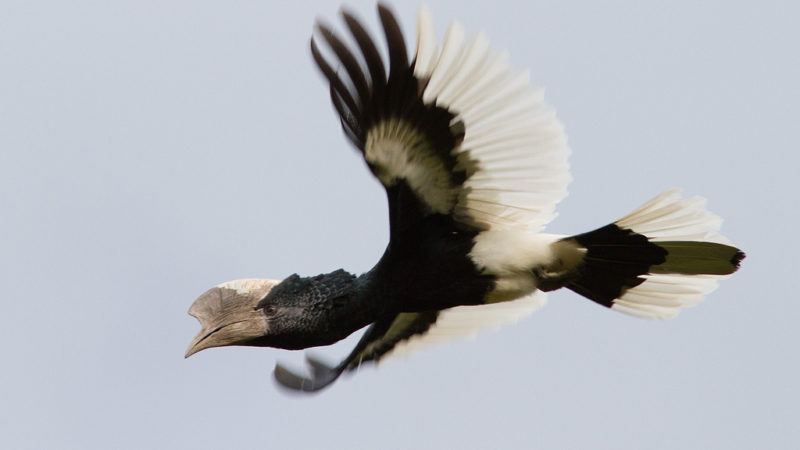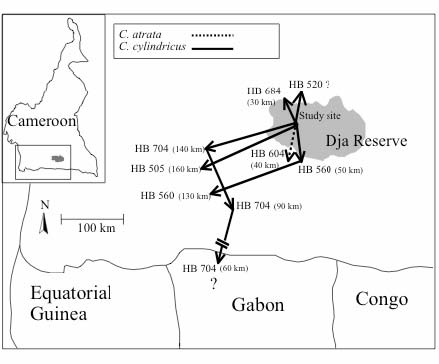Spatial and temporal patterns of frugivorous hornbill movements in Central Africa and their implications for rain forest conservation
Published Work | 2014 | Biotropica 46(6), 763–770
permalink
Research Project | 2016
The recent discovery by UCLA Center for Tropical Research (CTR) scientists that the large-bodied frugivorous hornbills (Ceratogymna sp., Fig. 1) of Central Africa make long-distance movements (Fig. 2) highlights their potential as important seed dispersers that help maintain the incredible tree diversity found in the Congo basin. Until the discovery that their abundance in particular areas varies greatly, these birds were thought to be stable residents with limited movements. They were, nevertheless, found to be critical members of the rainforest for their role in dispersing seeds and improving seedling survival for nearly a quarter of the 250 tree species found in the Dja National Park. However, research on the timing of fruiting events in the rainforest found that hornbill populations decrease dramatically as fruit resources run out during winter dry season. Radio telemetry research conducted by CTR at the time demonstrated that individuals moved as much as 290 km from the protected area. CTR plans to further study these hornbill movements using Global Positioning System (GPS) transmitters. In addition, this new project will track the availability of fruit resources used by hornbills in managed landscapes with thick and diverse shade canopies, such as cocoa agriculture, which can help support hornbills during their movements in food-lean months.
Hornbill movement patterns are a critical missing piece of our understanding of tropical rainforest dynamics that may have serious repercussions for the conservation of African tropical biodiversity. The consequences are twofold: 1) if critical resources and stopover sites are not identified and managed to ensure their suitability for hornbills, the dry season may act as a bottleneck for hornbill populations within protected natural areas and may limit natural forest processes, and 2) hornbill movements may have a profound effect on the regeneration of forests in managed landscapes following natural and anthropogenic disturbance. Encouraging or maintaining hornbill activity through management may be necessary to ensure that they continue to disperse seeds and foster the regeneration of diverse forests. Understanding and preserving hornbill movements outside protected areas is even more critical in the face of the bushmeat crisis and the enormous loss of mammal diversity and other important seed-dispersers, especially primates, throughout the Congo basin from hunting for commercial and subsistence use.
Figure 1. Black-casqued Hornbill (Ceratogymna atrata).

Figure 2. Long-distance movements by Ceratogymna atrata and C. cylindricus (from Holbrook et al. 2002).
UCLA’s International Research & Training Center in Cameroon hosts researchers such as Prof. Tom Smith and his team from the Center for Tropical Research. Prof. Smith leads the IRTC and shows here how the research team captures hornbill birds and attaches a satellite tracking device in order to track their movements across the Congo Basin for the first time.
Related Publications
Published Work | 2014 | Biotropica 46(6), 763–770
permalinkPublished Work | 2014 | Ecology and Evolution 4(17), 3456–3469
permalinkPublished Work | 2014 | Oecologia 125, 249–257
permalinkPublished Work | 2009 | Ostrich 2004, 75(3), 79–88
permalinkPublished Work | 2002 | Ecography 25(6), 745–749
permalinkPublished Work | 1998 | Journal of Tropical Ecology 14(3), 351–371
permalink